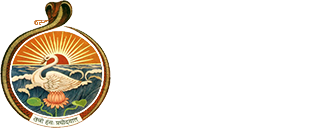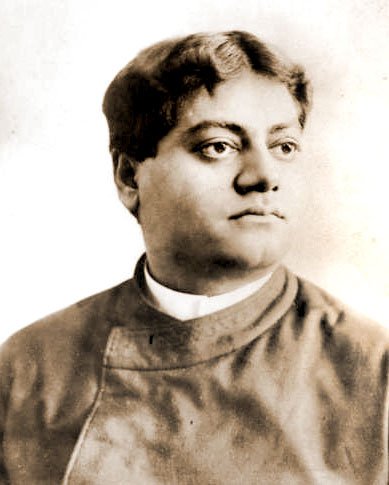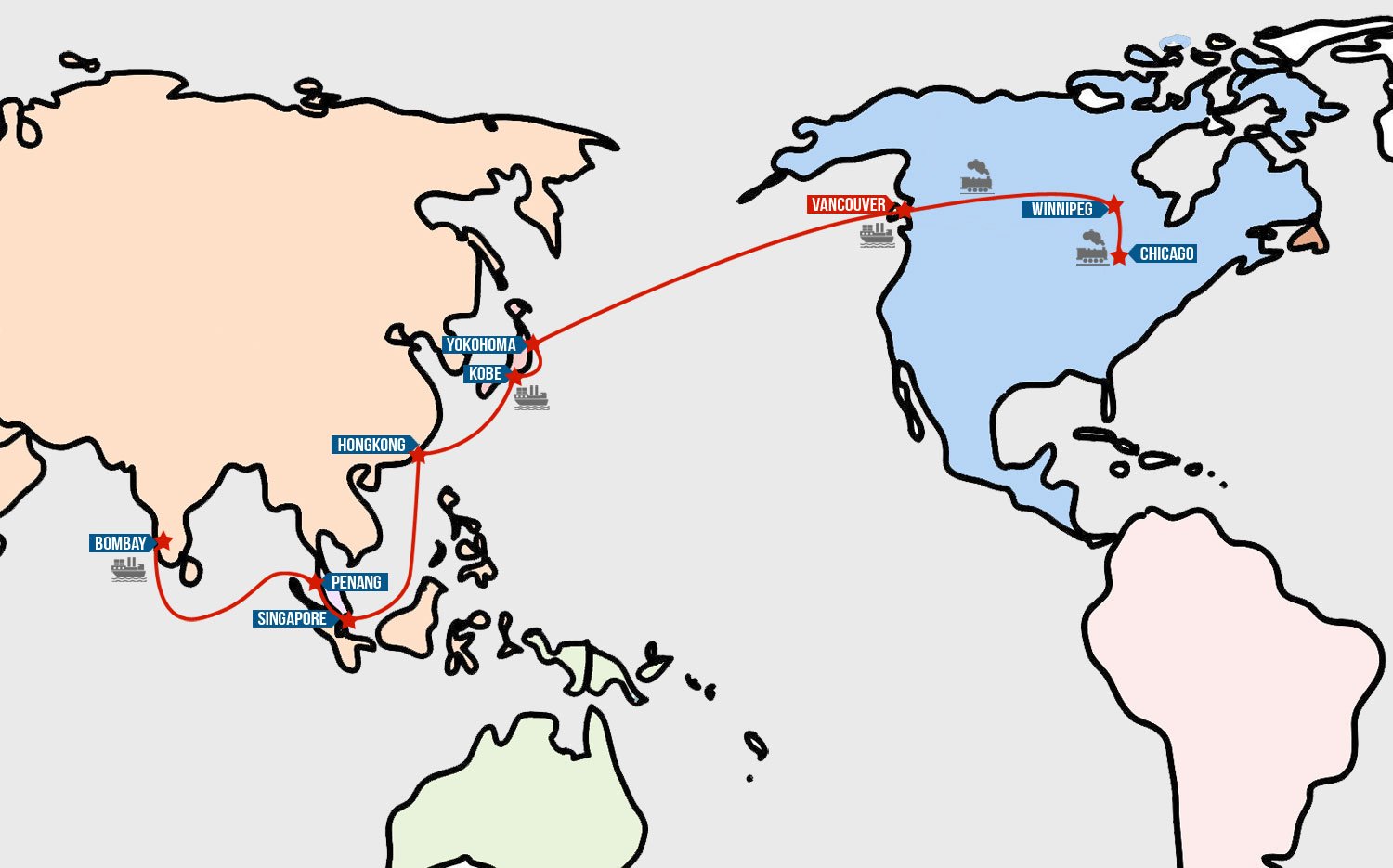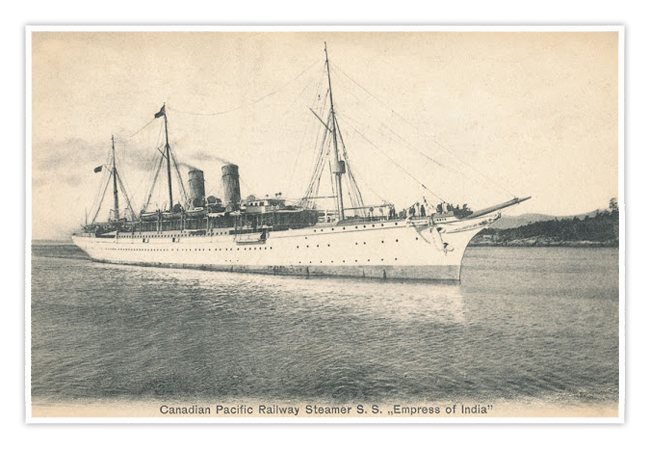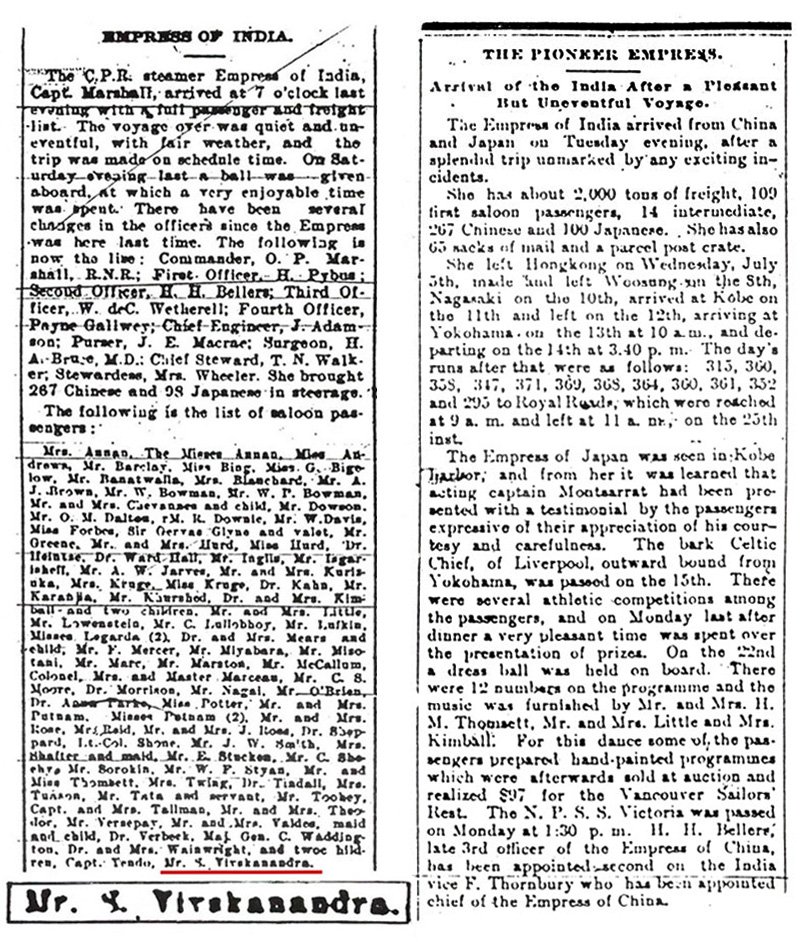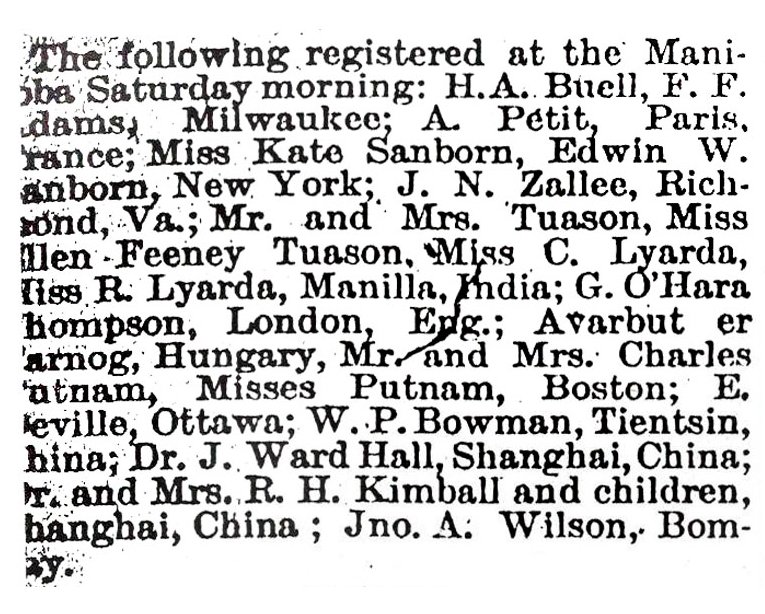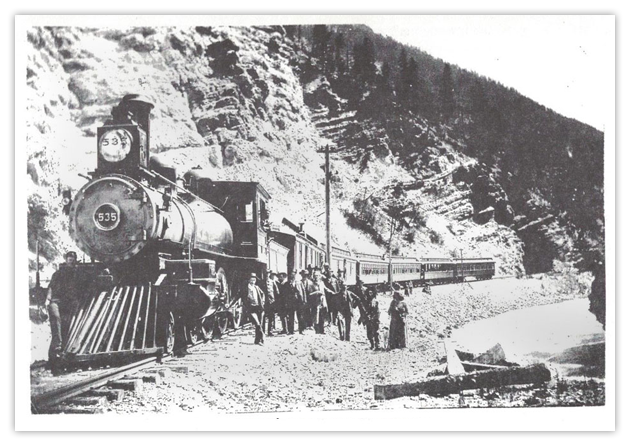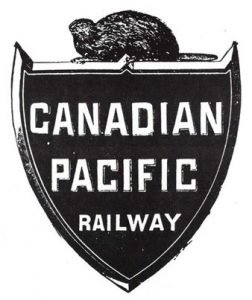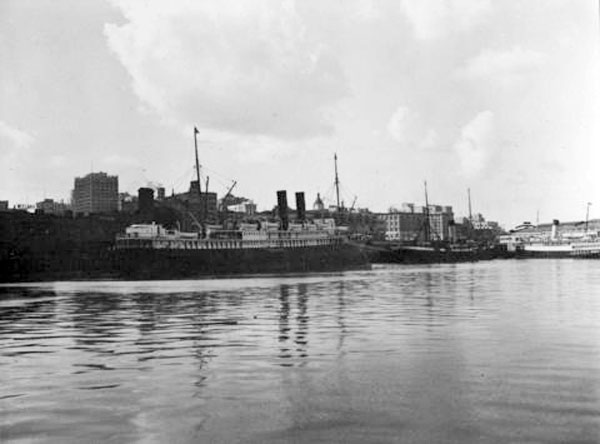INTRODUCTION
About 127 years ago, on 25 July 1893, the dynamic modern-day prophet from India, Swami Vivekananda, arrived in Vancouver, British Columbia, Canada, aboard the Canadian Pacific Liner, Empress of India. As the first ambassador of Hinduism to the West, he revealed the priceless truths contained in the Vedanta philosophy, that is, universalism and harmony of religions, and thus changed forever the thinking of a great many Westerners with regard to India and its religions. Thus, Swami Vivekananda’s arrival is a historic event, and his admirers in Vancouver feel especially honoured since he first set foot on North American soil here in Vancouver, British Columbia, Canada.
BRIEF BIOGRAPHY
Before relating Swami Vivekanada’s travelling experiences in Canada, it is relevant to trace the events which led to this journey. Briefly, his biography is as follows. He was born Narendranath Datta on January 12, 1863, in Kolkata, India. His parents were Vishwanatha Datta, a prominent lawyer of Kolkata, and Bhuvaneshwari Devi, a highly cultured and pious lady. Narendranath demonstrated exceptional all-around abilities, even as a boy: proficiency in athletics, talent in music, and facility in studies. This was due to his keen powers of understanding and a prodigious memory. He received a Western education and was considered a genius at school. But even from an early age he was haunted by questions about God: Was there a God, and if so, what was He like? He searched persistently, but in vain, for persons who could say that they had seen God, until he met Sri Ramakrishna, the great nineteenth century saint of India. Sri Ramakrishna replied that not only had he seen God, but that he could show God to Naren as well. Thus, Sri Ramakrishna, the simple rustic temple-priest taught the college-educated rationalist, and in less than five years trained him to perfection.
Sri Ramakrishna passed away in 1886 and left Narendranath, who was just twenty-three years old at that time, to execute his mission. Narendranath embraced monastic life, and became the leader of a select group of young men with whom he founded a monastery at Baranagore, West Bengal. Adopting the name of Vivekananda, he travelled extensively throughout India and observed her problems firsthand. He felt very keenly for the millions of common people living in a state of ignorance, starvation and helplessness, and longed to find solutions to their problems.
Drawn to Swami Vivekananda’s magnetic personality, the Maharajas of Mysore and of Khetri, and a few young men of Madras raised funds to send him to the forthcoming Parliament of Religions in Chicago, U.S.A., in order to represent Hinduism. At first, Swami Vivekananda was reluctant to embark on such a monumental journey, but two significant events convinced him that he should proceed to fulfill his divine mission. These were, firstly, the vision of his Master, Sri Ramakrishna, on the waters near Kanyakumari at the southern tip of India, beckoning him in the direction of North America; and, secondly, the blessings of Sri Sarada Devi, the Holy Mother, wife and spiritual heir to Sri Ramakrishna. Thus, realizing his mission, Swamiji embarked on his journey which was to have far-reaching consequences for the whole world.
THE JOURNEY
Swami Vivekananda’s first journey to the West began in Mumbai. Departing in June, 1893, he travelled by the steamer Peninsular, visiting Colombo, Penang (an island off the west coast of the Malay Peninsula), Singapore and Hong Kong. From Hong Kong he went to the ports of Nagasaki and Kobe, Japan. Then the Swami went over land to the cities of Osaka, Kyoto, Tokyo, and finally to Yokohama.
On 10 July 1893, just prior to his departure for North America, he wrote a lengthy letter from Yokohama to his disciple Alasinga Perumal in South India which describes in some detail and with considerable animation his travels since leaving India. It appears that Swami Vivekananda took every opportunity to make side trips and engage in sightseeing in each of the ports he visited thus far.
In contrast to this, our research reveals that the Swami did not engage in any extracurricular activities at all on the remaining portion of his journey from Yokohama, Japan, to Chicago, Illinois. Following is a timetable for this journey.
ARRIVAL IN VANCOUVER
The Wednesday, 26 July 1893, edition of the Daily World, a Vancouver newspaper, notes the departure time from Yokohama and the arrival time at Royal Roads, B.C. (Victoria) of the Empress of India. Evidently, the Royal Roads stop was for quarantine purposes, where passengers with some contagious disease were required to disembark and were not allowed to proceed to Vancouver. The Daily World of the same day also notes the arrival time of the Empress of India in Vancouver; that is, 7 p.m. on Tuesday, 25 July 1893. Since the 26 July 1893 edition of The Daily News-Advertiser, another Vancouver daily newspaper, also notes the ship’s arrival as 7 p.m. on the same evening, this may be taken as the exact moment when Swami Vivekananda arrived in the continent of North America.
The Daily News-Advertiser article also lists the saloon (first class) passengers. The last name on this list is “Mr. S. Vivekanandra”. The Daily World and Daily News-Advertiser articles are reproduced below:
In the microfilm version of The Daily News-Advertiser article, the third letter after the “v” is blurred and not clearly an “e”. Comparing this letter with others in the same article suggests that it is probably not an “e” nor an “a”, but that it most closely resembles the letter “s”. If this letter is an “s” it is clearly a typesetter’s error, and since the letter is illegible, we have used “e” above. The other spelling error, “dra” instead of “da” at the end of the name, probably came from the ship’s manifesto. Whether the manifesto had “Swami Vivekanandra” or “Mr. S. Vivekanandra” we may never know, but we note that only once does a first name appear in The Daily News-Advertiser’s list of passengers. Thus, assuming that the ship’s manifesto would contain more-or-less complete information, it is very probable that the newspaper employee responsible for transcribing the list made “Swami” into “S”., not knowing the word was a title rather than a first name, and then added the “Mr.”
Still, there is absolutely no doubt that this name refers to Swami Vivekananda and marks the very first time his name appears in the North American press. Of course, this was only the first of hundreds of such appearances during the years he spent there.
After examining the guest lists published in The Daily News-Advertiser for the Hotel Vancouver, the Manor, the Leland, and the Oriental hotels, the researchers found no evidence that Swami Vivekananda stayed in a Vancouver hotel the night of 25 July. They noted that Mr. Tata, the man who was to become the world-famous industrialist of India and who arrived with Swami Vivekananda on the Empress of India, did stay at the Hotel Vancouver. But, according to Canadian archivist W. Kaye Lamb, it is possible that the Swami remained on the Empress of India overnight. The Canadian Pacific Railway station was located adjacent to the dock where the ship lay moored. 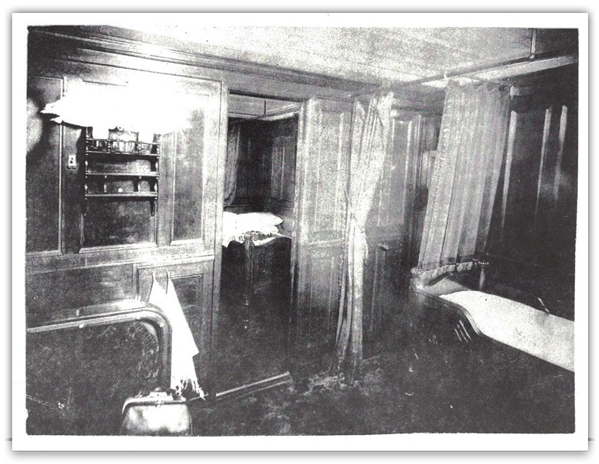 In fact, the tracks were built on a trestle over the water in order that the train could come very close to the steamships at dock. These were located rather close to the present Pan Pacific Hotel at the foot of Howe Street. Evidently, the southern shoreline of Burrard
In fact, the tracks were built on a trestle over the water in order that the train could come very close to the steamships at dock. These were located rather close to the present Pan Pacific Hotel at the foot of Howe Street. Evidently, the southern shoreline of Burrard
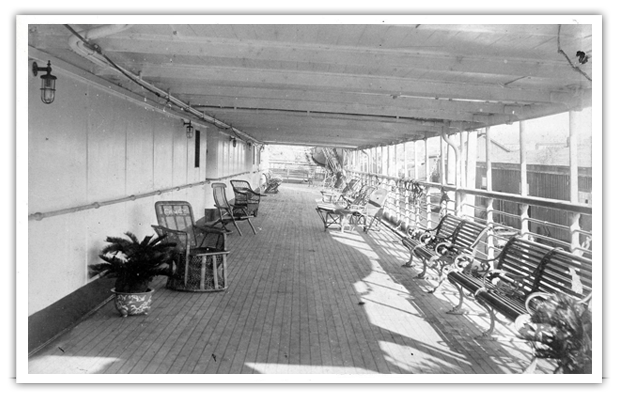 Inlet was quite different in 1893 from what it is today. Considerable landfill has since been applied to the area, so that the exact location of Swamiji’s docking would likely be under the ground of present-day Vancouver.
Inlet was quite different in 1893 from what it is today. Considerable landfill has since been applied to the area, so that the exact location of Swamiji’s docking would likely be under the ground of present-day Vancouver.
The researchers conclude that Swami Vivekananda boarded the CPR train at 10:45 a.m. the very next morning, Wednesday, 26 July 1893, fifteen and three-quarters hours after his arrival in Vancouver. He headed east for Winnipeg, Manitoba, a trip which normally took sixty hours. Newspaper evidence indicates that the train was running on time. Thus, Swami Vivekananda most probably arrived in Winnipeg, Manitoba, at about 10:45 p.m. on Friday, 28 July.
ARRIVAL IN WINNIPEG, MANITOBA
The historical Research Committee based its conclusions concerning these times by logical deduction from all collected findings. They were assisted by another researcher in Winnipeg who made the important discovery of a news item in the Monday morning, 31 July 1893, edition of the Manitoba Free Press, a Winnipeg daily newspaper. The item is reproduced below. It mentions the arrival of one “Swami Vevekananda” (another misspelling).
 Clearly, the Swami spoke briefly with a reporter in his first “press interview” in North America. Several errors occur in the published statement: the incorrect spelling of Vivekananda; the term “Hindoo priest” to describe Swami Vivekananda; and the word “congress” instead of “parliament”. We will not speculate on the source of these errors. However, the most significant mistake in this news item is the phrase: “arrived from the west last night”. If this were true, given the newspaper is dated July 31, it would mean that Swami Vivekananda arrived in Winnipeg on Sunday evening, July 30, and thus did not leave Vancouver until Friday morning, July 28: a stay of two days and three nights in Vancouver.
Clearly, the Swami spoke briefly with a reporter in his first “press interview” in North America. Several errors occur in the published statement: the incorrect spelling of Vivekananda; the term “Hindoo priest” to describe Swami Vivekananda; and the word “congress” instead of “parliament”. We will not speculate on the source of these errors. However, the most significant mistake in this news item is the phrase: “arrived from the west last night”. If this were true, given the newspaper is dated July 31, it would mean that Swami Vivekananda arrived in Winnipeg on Sunday evening, July 30, and thus did not leave Vancouver until Friday morning, July 28: a stay of two days and three nights in Vancouver.But the evidence presented almost certainly indicates that “last night” here refers to Friday night, 28 July. The error no doubt arose because the Manitoba Free Press did not have a Sunday edition. News items collected by reporters late Friday night or Saturday morning might have been received by the editors and typesetters too late for inclusion in the Saturday issue. These items could have remained untouched until they were typeset (late Sunday night or sometime after midnight Sunday) for the Monday morning edition. A careless editor or typesetter would not bother to make the necessary changes, in the interest of accurate reporting, for his Monday-morning readers. The researchers believe that the Swami’s “interview” took place either late Friday night when the train arrived or the next morning.
The proof that Swami Vivekananda arrived in Winnipeg on Friday night, 28 July 1893, is as follows:
Katherine Abbott Sanborn was an American educator, author, and lecturer. She was born in Hanover, New Hampshire, in 1839. For several years she served as Professor of English Literature at the acclaimed women’s university, Smith College, in Boston. She left that position in 1890 and, three years later, while travelling with her brother, Edwin W. Sanborn, met Swami Vivekananda on the Canadian Pacific Railway train en route from Vancouver to Winnipeg. Although Miss Sanborn does not provide an exact date, she writes about the impressionable meeting in her book “Abandoning an Adopted Farm” (a sequel to her book “Adopting an Abandoned Farm“) published in 1894.
In a letter written a few months later, Swami Vivekananda mentions the Sanborns and the fact that he visited them in the Boston area and that he appreciated their kindness to him. Some writers believe that the Swami met Miss Sanborn on a train to Boston, but likely they did not have access to the 1894 book or the following newspaper data.
In the same 31 July 1893 edition of the Manitoba Free Press there is a registered guest list for the Manitoba Hotel as of “Saturday morning”.
In view of an actual day being reported here, the researchers assume that the information in the newspaper with respect to this date is accurate. Among the registrants the investigators found the names of Kate and Edwin Sanborn. This places Miss Sanborn in Winnipeg on Saturday morning, July 29, 1893. The Historical Research Committee reasonably concludes that since Miss Sanborn arrived from the West and since she met Swami Vivekananda on the Canadian Pacific Railway train as she claims in her book, then they both arrived in Winnipeg on Friday night, 28 July 1893.
There is some ambiguity in the Manitoba Free Press regarding the exact time of arrival of this train from Vancouver. It may be that, due to a devastating storm on the Canadian prairies a few days before, it arrived several hours late, that is, in the very early hours of Saturday morning instead of the evening before.
Again, the researchers could not find any evidence that Swami Vivekananda stayed in a hotel in Winnipeg. The Manitoba Free Press refers to the arrival of several CPR “cars” full of passengers bound for the World’s Fair in Chicago. These cars were routinely detached from the CPR train and were shunted to the southbound train for Chicago via Minneapolis, while the CPR train continued eastward from Winnipeg. The Historical Research Committee logically assumes that the Swami was among these passengers and that he had remained aboard the railway car overnight in Winnipeg. Thus, he would have left Winnipeg for Chicago on Saturday, arriving in Chicago approximately thirty hours later on Sunday evening, 30 July 1893.
THE TRIP ACROSS CANADA
What were the Swami’s impressions as he travelled across the North Pacific and Canada? There are precious few references in Swami Vivekananda’s writings to the trip after Yokohama. Indeed, we can only wonder what he thought of the untamed and boisterous Canadian towns after visiting the ancient cities of the Orient.
Although Vancouver was a bustling port city of 18,000 people in 1893 and served as the hub of commerce and shipping, sea and rail, for the northwest coast of America, it was still rather small and sparsely populated compared to the larger centres of Asia already visited by the Swami. Furthermore, Vancouver was somewhat unruly in those days. For example, several gunshots were heard each day within range of the Hotel Vancouver. It may well be that Swami Vivekananda observed these features first-hand.
There are three possible reasons which account for the Swami’s lack of side trips and sightseeing during his trip from Yokohama to Chicago: time, money and the weather. Firstly, Swami Vivekananda was under the impression that the Parliament of Religions was to begin earlier than the fixed date. Upon hearing from the other passengers that the World’s Fair had already opened, he would certainly have been eager to reach Chicago at the earliest possible date, since his participation in the Parliament was the principal purpose of his trip to North America. Fortunately, he arrived about six weeks before the opening of the Parliament.
Secondly, the Swami spent his money more quickly than he had planned. He left Mumbai with 187 pounds sterling. Less than three weeks after his arrival in Chicago, he wrote from America that this amount had come down to 130 pounds. (This shows, however, that he did not arrive penniless in Chicago as some authors suggest.) After some calculations made during his travels, he might well have concluded that, for financial reasons, he could ill-afford to deviate from the straight and narrow path to Chicago.
Thirdly, the most significant factor regarding Swami Vivekananda’s uninterrupted trip from Yokohama to Chicago was the unexpected climate. In nearly every reference to the North Pacific and Canada in his letters, written either in English or his native language Bengali, the Swami mentions the cold temperatures. His benefactors in Chennai, India, 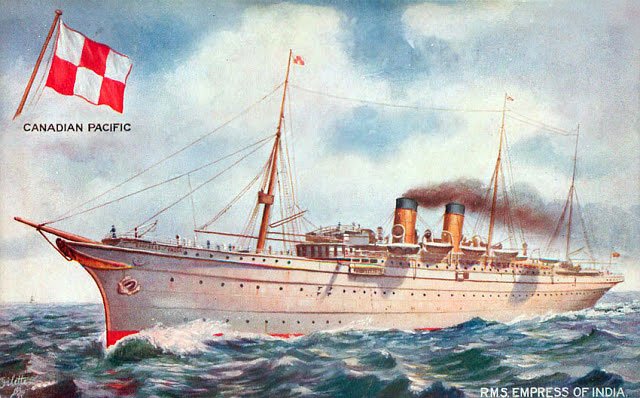 had given him silk apparel. Apparently, neither they nor the Swami had a clear idea about the sort of weather he would encounter. He wrote from Massachusetts in August 1893: “New England is so cold in August requiring fires in the morning and night. Canada is still colder. I never saw snow on such low hills as there.” Elsewhere he mentioned that he “suffered much for want of warm clothing” during his Northern Pacific trip. In a letter in Bengali, he mentions that the captain of the Empress of India gave him a cloak to wear. In this letter, he also describes his favourable impressions of the beauty and grandeur of the Canadian landscape, particularly of the Rocky Mountains. The Historical Research Committee notes that the weather during the full length of Swami Vivekananda’s trip was considered warm and fair, with daytime temperatures in the 70s and nighttime temperatures remaining above 50 degrees Fahrenheit. The Swami’s statements are therefore relative to his living in India for the first thirty years of his life.
had given him silk apparel. Apparently, neither they nor the Swami had a clear idea about the sort of weather he would encounter. He wrote from Massachusetts in August 1893: “New England is so cold in August requiring fires in the morning and night. Canada is still colder. I never saw snow on such low hills as there.” Elsewhere he mentioned that he “suffered much for want of warm clothing” during his Northern Pacific trip. In a letter in Bengali, he mentions that the captain of the Empress of India gave him a cloak to wear. In this letter, he also describes his favourable impressions of the beauty and grandeur of the Canadian landscape, particularly of the Rocky Mountains. The Historical Research Committee notes that the weather during the full length of Swami Vivekananda’s trip was considered warm and fair, with daytime temperatures in the 70s and nighttime temperatures remaining above 50 degrees Fahrenheit. The Swami’s statements are therefore relative to his living in India for the first thirty years of his life.
All these factors, therefore, contributed to the very short time that Swami Vivekananda spent in Canada.
ACKNOWLEDGMENTS
The Historical Research Committee, Vivekananda Vedanta Centre of British Columbia is indebted to the following for their cooperation in the preparation of this article.
- B.C. Archives and Records Service
- Canadian Pacific Archives
- Hotel Vancouver
- Vancouver City Archives
- Vancouver Maritime Museum, Mr. Leonard McCann
- Vancouver Public Library, in particular, the Fine Arts Division, Northwest History Room
- University of British Columbia, Main Library
- Mr. Rainer Kossman, Winnipeg, Manitoba
- Mr. W. Kaye Lamb, Vancouver, British Columbia
- Mr. Scott Wirth, Seattle, Washington
BIBLIOGRAPHY
- Gambhirananda, Swami, Yuganayaka Vivekananda, v.1, Kolkata, Udbodhan House, 1985.
- Lamb, W. Kaye, Empress to the Orient, Vancouver: the Maritime Museum, 1991.
- Letters of Swami Vivekananda, Kolkata: Advaita Ashrama, 2nd (new) ed., 1964.
- Lokeshwarananda, Swami, The Ramakrishna Movement, Kolkata, Ramakrishna Mission Institute of Culture, 1989.
- Lokeshwarananda, Swami, Swami Vivekananda at a Glance, Kolkata, Ramakrishna Mission Institute of Culture, 1989.
- Nelson, Elva, A Bird’s-eye View: Vivekananda and His Swamis in Boston and Vicinity, Boston, Ramakrishna Vedanta Society of Massachusetts, 1992.
- Prabuddhaprana, Pravrajika, Tantine: the Life of Josephine Macleod, Kolkata, Sri Sarada Math, 1990.
- Sanborn, Kate, Abandoning an Adopted Farm, New York, D. Appleton & Co., 1894.
- Swami Vivekananda, 1863-1902, Sri Ramakrishna Math, Chennai, 1991.
- Turner, Robert D, The Pacific Empresses, Victoria, Sononis Press, 1981.
The Historical Research Committee of the Centenary of Swami Vivekananda’s Arrival to the West consisted of the following members:
- Mrs. Mary Racys-Fluxgold, Chairperson
- Dr. Nalini Bhat
- Dr. Allen R. Freedman
- Mr. Terry Jang
- Mrs. Mina Ry
